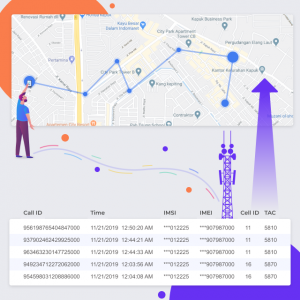Understanding Network Data
The present article is part of a blog series about Radio Access Network (RAN) topics to quickly understand the data generated in the RAN and their importance for Mobility Intelligence. The mobile network data is classified into two main categories, Call Detail Records (CDR) and Call Trace Data. Although these two data types share a similar structure, they possess different spatial-temporal properties. In this first blog, we will explore Call Detail Record (CDR).
What is Call Detail Record (CDR)?
A Call Detail Record (CDR) is an accounting record that contains information about how subscribers utilize a phone system. A CDR report provides data about each mobile communication (such as voice call, SMS, and internet). This data and its format may vary according to the Mediation System used by the telecom to collect the CDR. Nonetheless, it typically includes:
- Date and time of the call
- Duration of the call
- Subscriber phone number
- Location of cell tower connected
- Device used
- Cause for call termination
- Type of call
- Cost of call
It is worth mentioning that the data contained in a CDR report correspond to the attributes of the call and not to the content within it.
What are its uses?
CDRs play a critical role in the Telecom industry, especially for billing and accounting purposes. Thanks to it, operators can ensure the revenue generated by automatically extracting the CDR, sending to the billing system, and create the customer invoice. CDR represents the proof of the telecom service usage to the operator and is amply required to track and manage profitability.
Throughout the years, CDRs have been optimized to include more information and reveal new mobility patterns. This can allow for a vast number of use cases such as network monitoring, traffic analysis, fraud detection, customer care, facility capacity planning, among others.
How are these mobility patterns revealed?
CDR data is a handy source to pinpoint people’s location. As mentioned above, it contains time stamps of mobile communications and the geographic coordinates of the cell towers where a subscriber’s mobile phone connects for these calls to happen. Through this data, the location of a specific individual can be approximated.
A specific mobile phone has many mobile communications in a day, generating many CDRs. Through obtaining the sequence of location data recorded on all the CDRs, the movements of an individual can be traced. Furthermore, when aggregating these individual movements, it is possible to track the spatial-temporal distribution of a target population.

However, the use of these data presents some challenges. First, the antenna locations do not allow pinpointing the accurate location of mobile phone users. Second, it is required an active phone usage for the CDRs to be generated (the sampling rate can vary from a few minutes to several hours). And third, CDR only records one position during a mobile communication (e.g. a voice call). Despite these challenges, proximity location provides excellent spatial patterns that reflect population movement; which provides a competitive advantage for solving humanitarian crises and generating business innovations.
CDR importance for COVID-19
In a health crisis such as COVID-19, spatial-temporal analyses sourced by CDR data are considered an essential input for policy intervention, control of the pandemic, and resource allocation. The reason is that it provides government authorities and public health experts with an in-depth and quantitative understanding of population movement and transmission patterns over time.
What is RealMotion, and why do you need it?
RealMotion™ is a location-centric platform. It leverages network data and applies mathematical modelling and AI techniques to reveal exclusive mobility insights for developing tailored services and applications.
RealMotion™ for Public Health turns mobility data into actionable intelligence against COVID-19. It enables multiple use cases to provide a holistic assessment of the COVID-19 pandemic’s impact and save lives; such as Subscriber Density, Inbound Traveler Monitoring, Group Gathering, Quarantine Violation, and Lock-down Compliance.
Summary
Call Detail Records (CDR) data contains information about mobile subscribers communications; including the location of the connected cell tower. From this information, the subscriber’s position can be approximated. Furthermore, time-based and current dynamics of population movements can be estimated. This mobility intelligence is very crucial in solving health crises such as Covid-19 since it provides a clear understanding of the virus patterns spreading. Ultimately, it can lead to better support and preparation and more lives saved.

